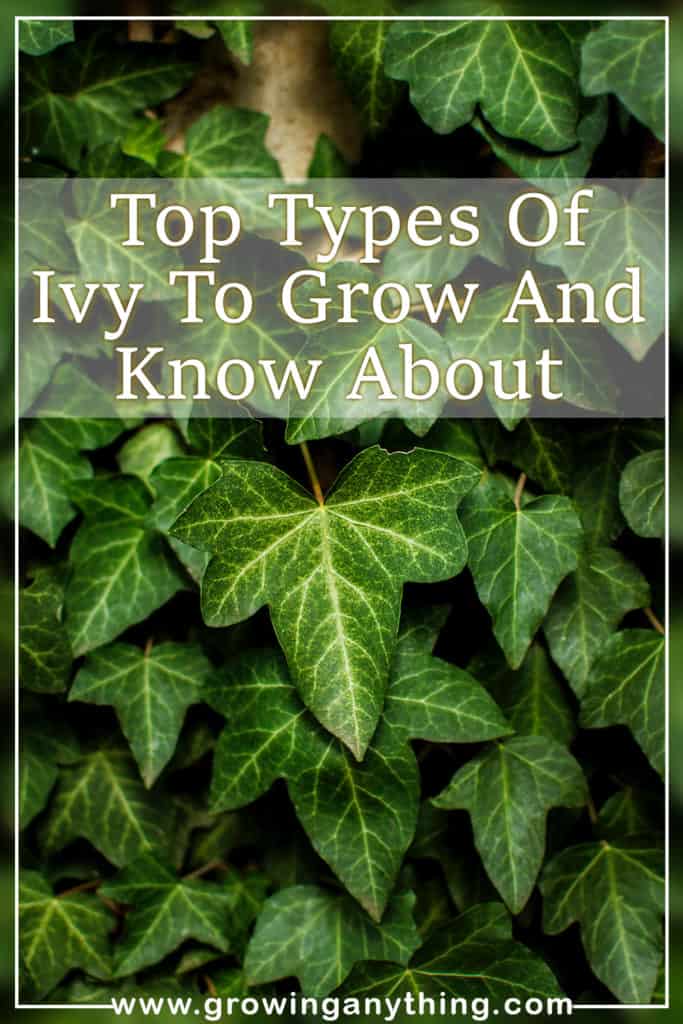30 Difference Types of Ivy
Are you interested to know more about different types of ivy? Here is a treat just for you! I will walk you through the most amazing varieties of this climbing or trailing plant!
The scientific name of ivy is Hedera, and the English ivy is the most common type. Ivy is often associated with buildings and hanging baskets.
Most of the varieties are vigorous growers and require close attention. If you don’t prune them regularly, these plants can overpower any surface they come across!
But, some Ivy varieties have significant benefits, such as air purification and anti-inflammatory properties!
Keep reading to find out more interesting information on different types of ivy plants!
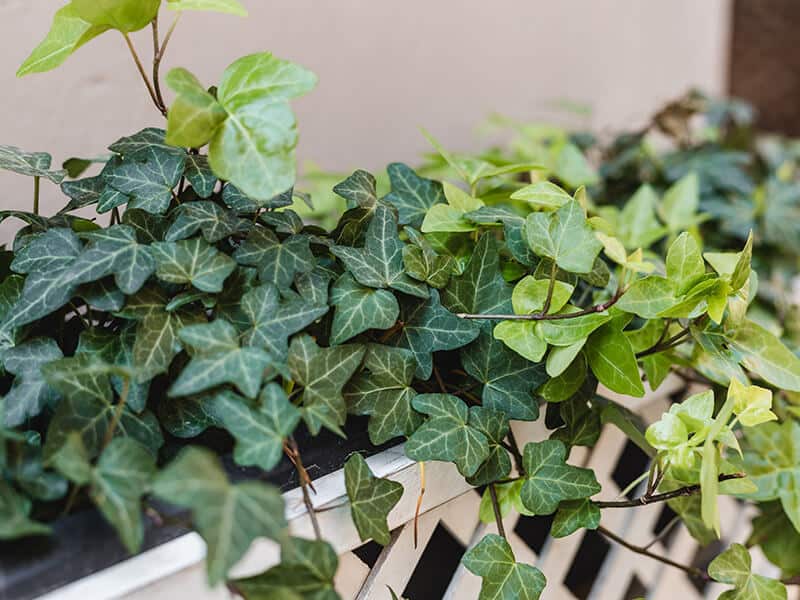
#1 Azores Ivy
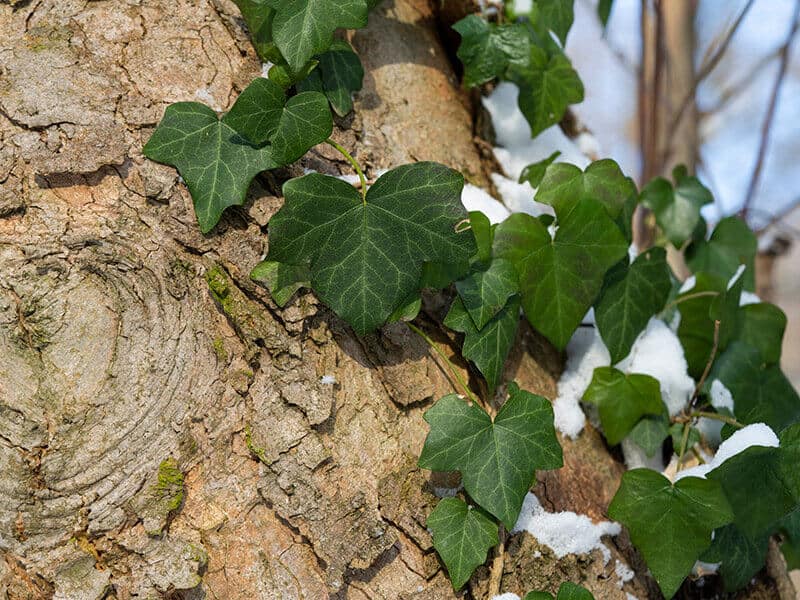
Let’s start with something not very common – Hedera Azorica or Azores ivy. The plant is native to Azores Islands and is a low maintenance plant. It thrives in moderately moist soil and can adapt to pretty much all lighting conditions.
Hedera Azorica is an evergreen climber, hardy in zones from five to ten. Sandy or clay soil is ideal for the plant!
#2 Persian Ivy
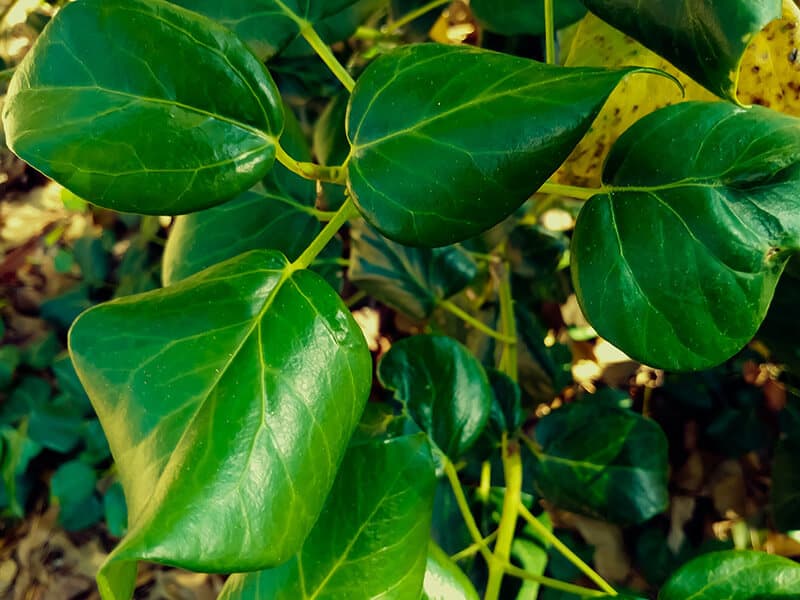
Hedera colchica is a botanical name of the plant Persian ivy. The plant is a vigorous climber and can climb up to 100 feet if left unattended. Persian ivy grows as a ground cover, if there isn’t a vertical structure nearby,
This Ivy is easy to grow but isn’t frost hardy. You can mulch heavily around the base to protect the roots in colder climates.
#3 Boston Ivy
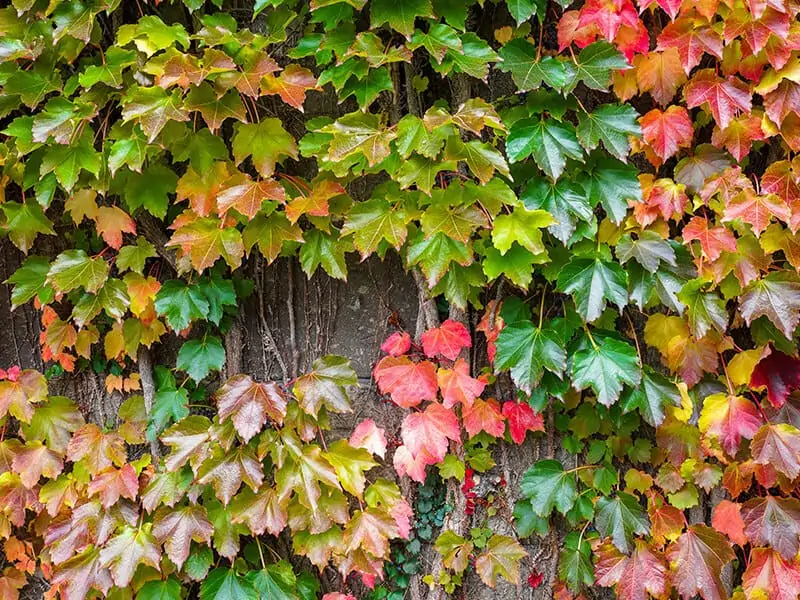
Parthenocissus Tricuspidata or Boston ivy is a flowering variety of ivy, native to Asia and one of the most popular plants in the USA. A prestigious college association also carries its name!
Boston ivy is simple to grow, and it requires occasional pruning to stay good-looking.
The vine looks stunning in spring, and in fall gets delightful color. It makes a better choice than English ivy, because of the beautiful visual appearance year-round!
Mature Boston ivy grows up to 50 feet!
You can see this video to know more:
#4 Cyprus Ivy
Hedera Cypria is endemic to Cyprus and is easily recognizable by its pointy leaves with silver veins. The plant is a slow grower, and can grow from 60 to 90 feet when fully mature.
Cyprus Ivy is an evergreen plant, which climbs on vertical surfaces or grows as ground cover.
#5 Cape Ivy
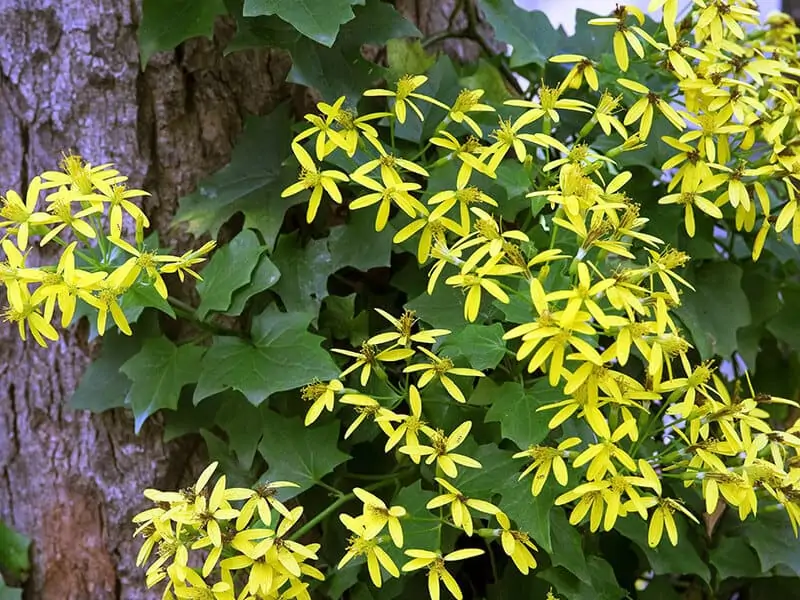
Senecio angulatus or Cape ivy is native to South Africa. The plant features thick and leathery foliage, and dense clusters of charming yellow flowers!
Cape ivy is considered weedy because the parent plants disperse their long-lived seeds far away! The plant is tolerable to salt, drought, shade, wind and many other conditions.
#6 Canarian Ivy
Hedera Canariensis requires regular water during most seasons. But, in winter, you should wait for the soil to dry before you water the plant. To preserve the beautiful appearance of the foliage, you can spray the leaves with lime free water occasionally.
Use a mineral fertilizer in the growing season to boost the growth of the plant!
#7 Swedish Ivy
Plectranthus Australis is a fast-grower, invasive plant that originates from South Africa. It blooms with pale purple flowers and the flowers may appear year-round. Ideal conditions for growing Swedish ivy are humus soil, moderately moist, well-draining, and part shade!
#8 Pastuchov’s Ivy
Hedera pastuchovii is an interesting-looking ivy with silvery, sword-shaped foliage and distinctive veins. The most common cultivar is Mrs. Ann Ala. Compared to some other types of ivy, the Pastuchov’s ivy remains compact, as it grows up to 15 feet. The plant isn’t picky about the soil and lighting!
#9 Japanese Ivy
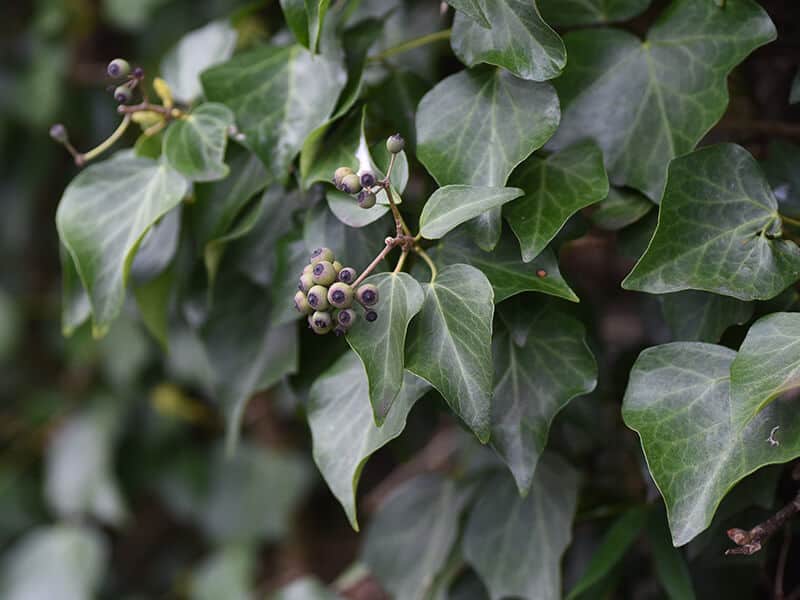
Hedera Rhombea or Japanese ivy is common on trees, cliffs, and rocks. But the plant can also spread on the ground if you plant it far away from vertical structures. The plant has rhomboidal leaves, hence the botanical name.
Japanese ivy has low poison features, but you should still be careful with it around pets and children.
The plant is hardy in zones 8a to 9b!
#10 Irish Ivy
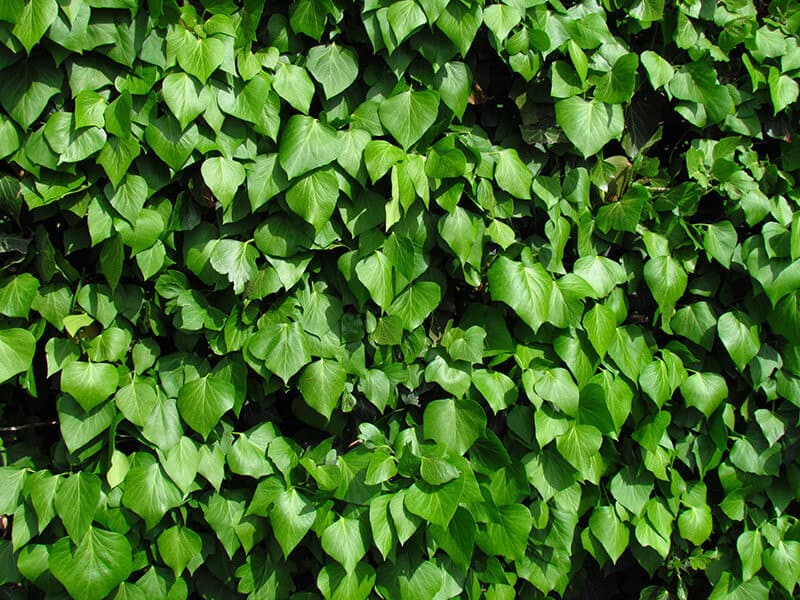
Hedera Hibernica or Irish ivy is best known for its bright green foliage. It is a variety of ivy that is mostly used for fence and wall covering, because of the dense foliage. Because it has fast growth, Irish ivy can grow up two feet per year. It blooms with lovely yellow flowers!
#11 Iberian Ivy
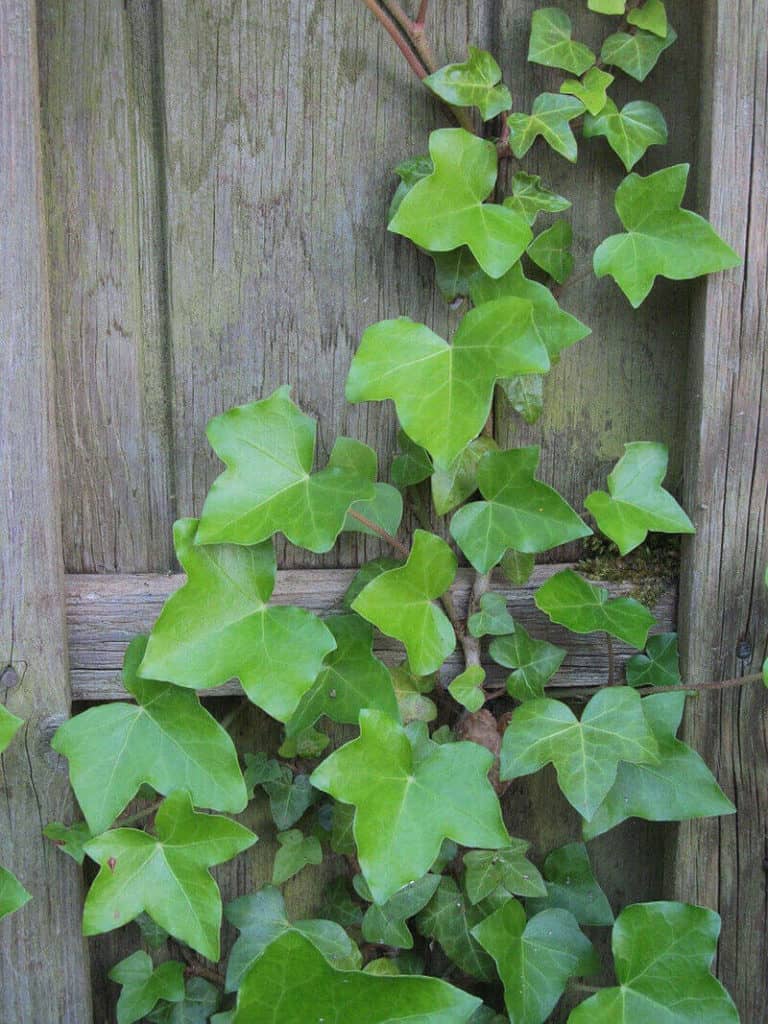
Woody Iberian ivy is poisonous to pets. It climbs easily on any nearby structure, including fences and walls. Hedera Iberica adds an interesting effect to every landscape because of the dark green, grayish foliage which turns bright red in the fall.
Historical buildings in Spain, Portugal and Morocco are covered with Hedera Iberica!
#12 English Ivy
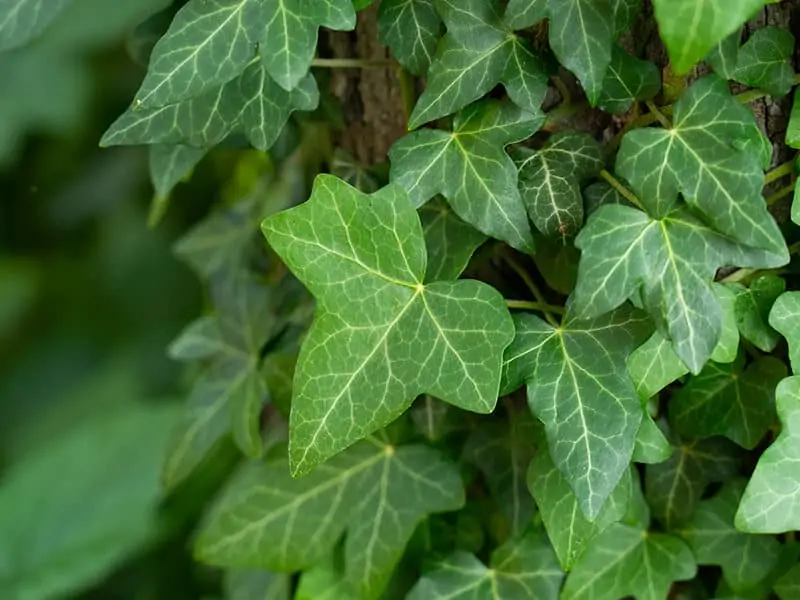
English ivy or scientifically Hedera helix is the most common ivy variety you’ll come across. The plant grows in the shade, in soil amended with organic matter. You can use compost just before planting.
You can start your Hedera helix from stem cuttings. Interestingly, English ivy is an invasive plant outdoors. But, if you grow it indoors, it will never become empowering and it will look great in hanging baskets.
You can see this video to know more:
#13 Himalayan Ivy
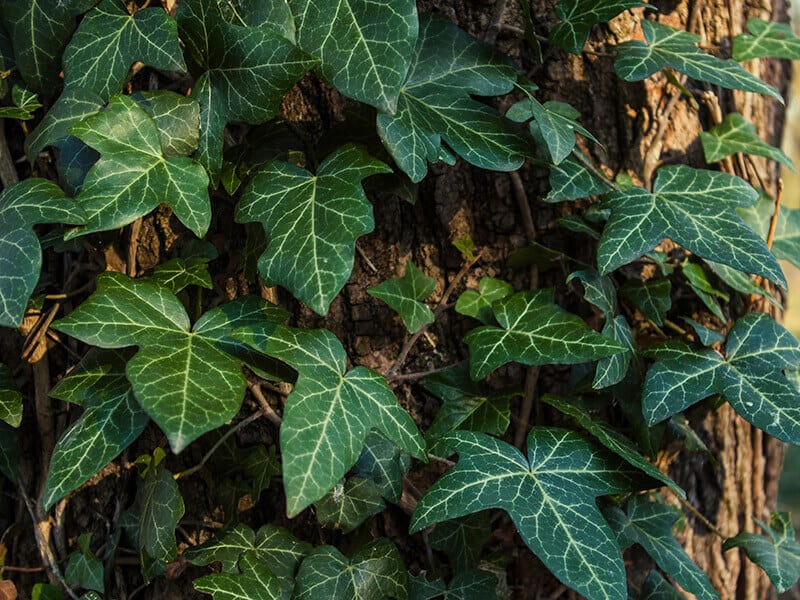
Hedera nepalensis or Himalayan Ivy grows best in alkaline soil, in zones from seven to ten. It can climb up to 50 feet in height and spread around 16 feet.
Himalayan Ivy is tolerable to full shade and semi-shade areas. The plant loves moist soil. Because it can tolerate air pollution, you can grow it in polluted cities!
#14 Manda’s Crested Ivy
Manda’s Crested Ivy features glossy green leaves with three or five lobes. The plant is hardy in USDA hardiness zones from five to ten and can adapt to full sun or semi-shade conditions.
The ideal soil type of Hedera helix Manda’s is sandy loam. The plant needs moderate moisture.
#15 Shamrock Ivy
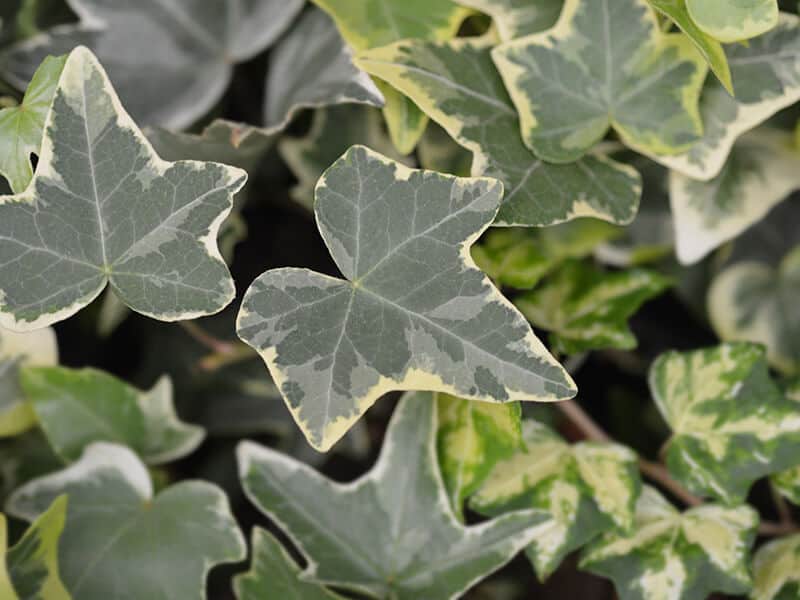
Hedera helix Shamrock requires well-draining soil and several hours of sunlight per day. The plant is quite versatile. You can grow it as wall or ground cover, use it as a flower bed, or enjoy its cascading shape in hanging baskets!
Shamrock ivy is a low-maintenance plant, which will thrive even if you neglect it. You’ll have to prune it to control the spreading and keep the plant tidy.
#16 Russian Ivy
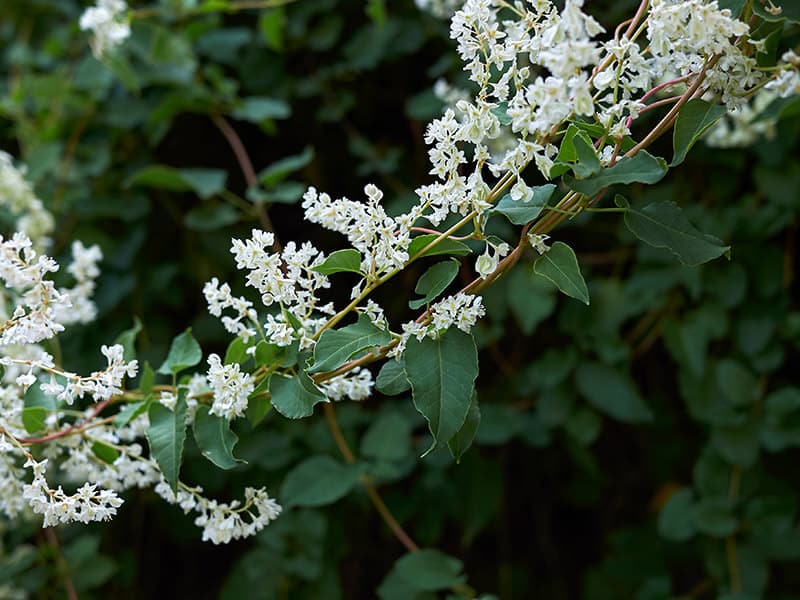
Fallopia baldschuanica or Russian ivy is very easy to grow in all locations. The plant isn’t picky about the soil quality or sun exposure. The only thing that it needs is good drainage in the soil. Russian ivy produces more foliage than flowers in rich soil. But it is equally pretty!
You can plant it near the trellis to develop a wonderful display!
However, get ready for regular pruning, because Russian ivy can soon go out of control!
#17 Bush Ivy
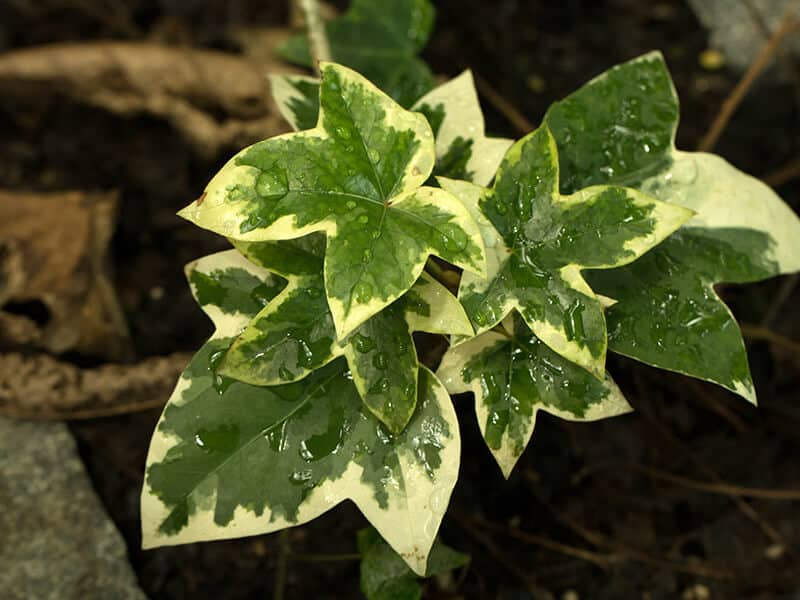
The scientific name of Bush ivy is Fatshedera Lizei, and the plant is sometimes called Tree ivy. It is an evergreen plant, which thrives in indirect light in the coastal area. But, in colder climates, you can grow it in full sun locations. The plant likes acidic or slightly alkaline soil with sand. The soil needs to be consistently moist, but well-drained for the plant to develop.
The plant can also be grown indoors, as a houseplant.
#18 Algerian Ivy
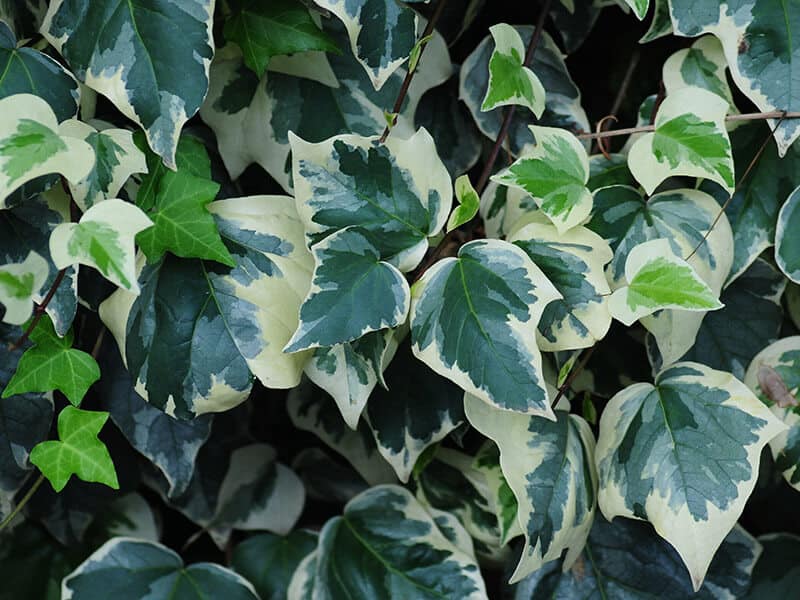
Hedera algeriensis or Algerian ivy needs evenly moist soil, ideally humus-rich. But, it can adapt to a variety of soil types, as long as the soil is fertile and well-draining. You can use a slow-release fertilizer in spring to boost the growth and ensure glossy and beautiful foliage.
#19 Madeiran Ivy
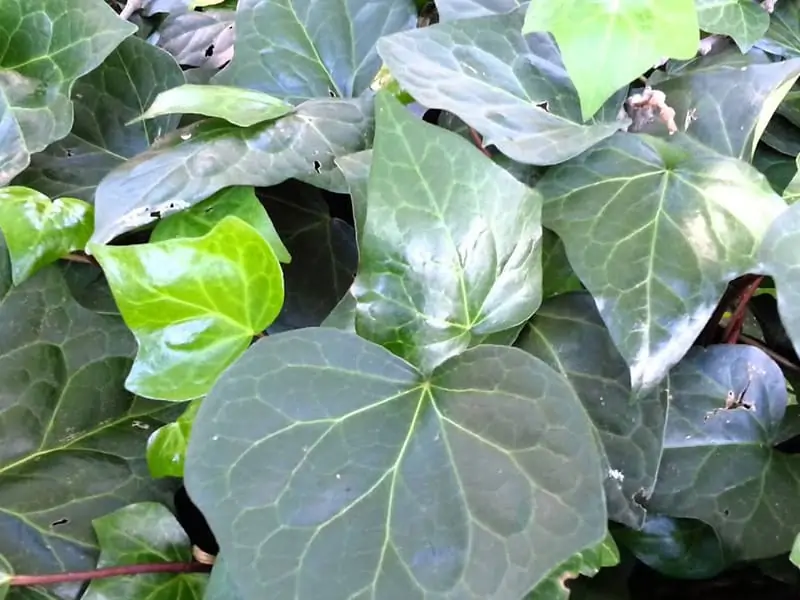
Hedera maderensis or Madeiran ivy is endemic to Madeira island. The plant grows on slopes, in the soil, around trees and doesn’t require any specific growing conditions.
Between April and December, Madeiran ivy develops lovely greenish-yellow flowers! The fruits are globular and black.
The plant is actually quite young in scientific research and has been described recently.
#20 Moroccan Ivy
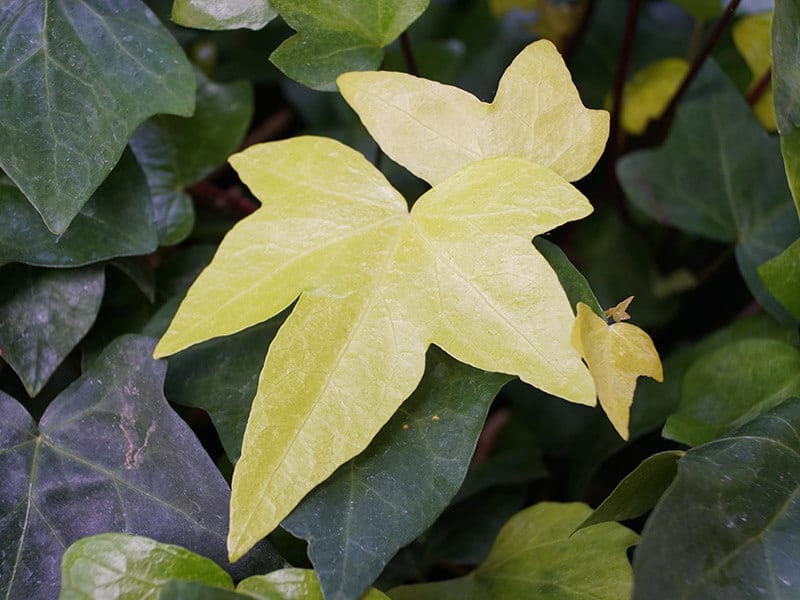
Hedera maroccana is an evergreen, woody vine which can grow up to 100 feet. It is common for rocks, cliffs, and any vertical structure. Moroccan ivy features greenish, brown stems, sometimes covered with red or purple hues.
Moroccan ivy has been used in floral arrangements, because of the beautiful and symmetrically-lobed leaves.
#21 Sulphur Heart Ivy
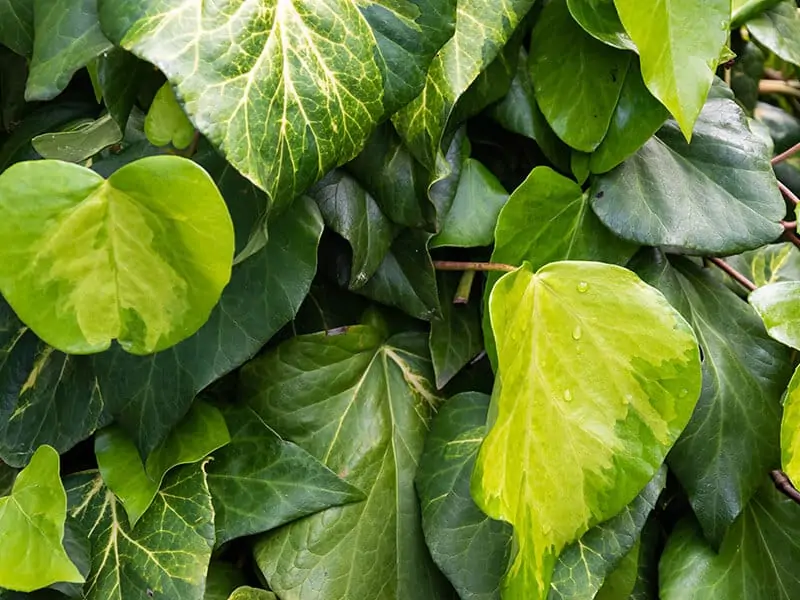
Hedera colchica Sulphur Heart is easy to recognize by its dark green foliage with large splashes of yellow color. The leaves are quite large and broad. This evergreen climber is a vigorous grower, which needs between five and ten years to reach its maximum height.
Sulphur Heart is low-maintenance ivy, which grows in full sun or partial shade.
#22 Adam Ivy
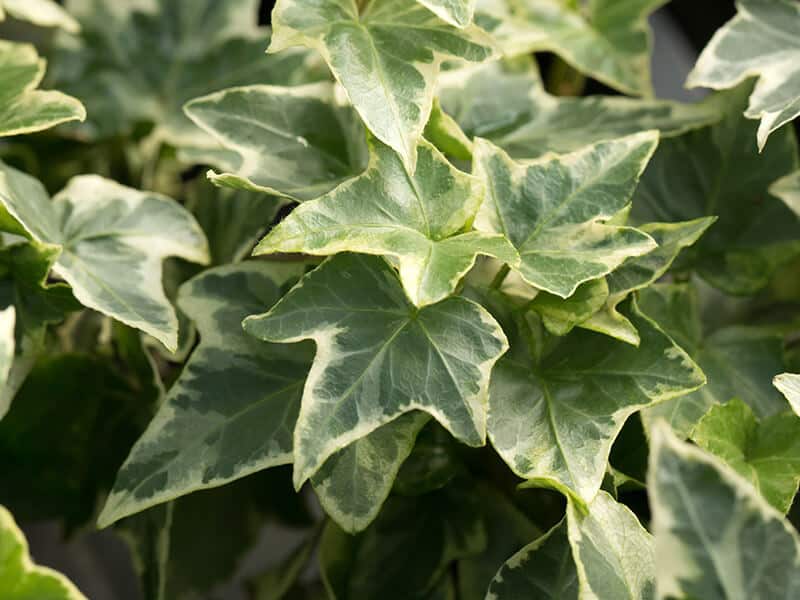
Hedera helix Adam or Adam’s Ivy is one of the most beautiful ivy varieties. It features large dark green leaves with white edges!
Even though it is an evergreen, vigorous climber, you can also grow it inside, as a houseplant. The plant develops yellow-green blooms, which are replaced with blackberries!
#23 Anita Ivy
Hedera helix Anita is a compact plant and is mostly used for topiary design. The American Ivy Association named it the ivy of the year in 2001.
The plant is adaptable but grows best in fertile, humus-rich soil with excellent drainage.
Anita ivy has shiny, three or five-lobed leaves which are slightly folded.
#24 Asterisk Ivy
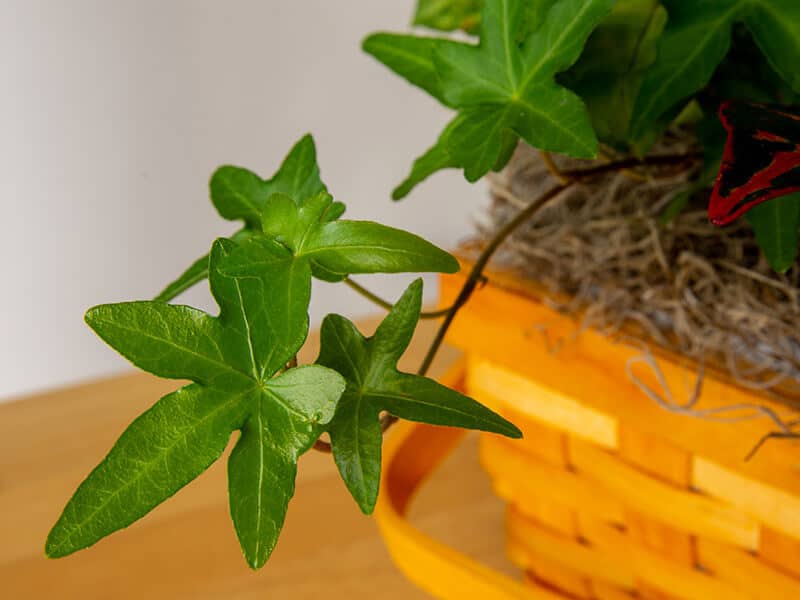
If you are looking for an Ivy to grow in a hanging basket, choose Hedera helix Asterisk. It looks stunning in hanging baskets, and it is easy to grow.
The plant has solid green foliage, which can tolerate shade. If you get the variegated version of Asterisk ivy, expose it to part sun to preserve variegation.
You can see this video to know more:
#25 Aloma Ivy
Aloma Ivy rarely grows taller than seven inches, when you grow it like a creeper. But, if you provide a vertical structure for it to climb on, Hedera helix Aloma can grow up seven feet.
The plant grows slightly acidic to neutral soil. The ideal time to plant it is in early spring.
Because it is full-frost hardy, winter care isn’t required. You can grow the plant almost everywhere!
#26 Amber Waves Ivy
Mature Hedera helix Amber Waves develops fragrant flowers in late summer or early fall. If you plant it later in the year, Amber Waves ivy may bloom in late fall or early winter.
The plant attracts bees, various birds, and butterflies.
This ivy is adaptable to different lighting conditions, and can grow in full sun, semi-shade, and full shade areas!
#27 Tussie Mussie Ivy
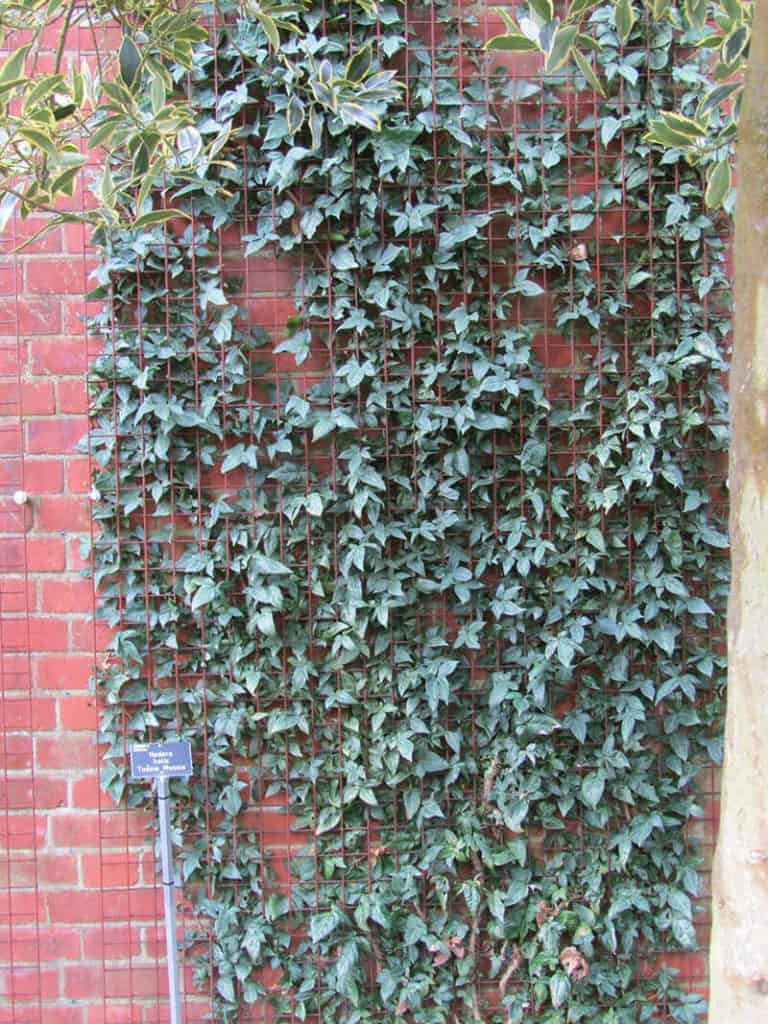
Hedera helix Tussie Mussie is a cultivar of common ivy with delicate and attractive leaves. But, the care is similar to the care for English ivy.
The leaves are variegated with cream white and yellow. Unfortunately, Tussie Mussie isn’t very easy to find in local nurseries.
#28 Goldchild Ivy
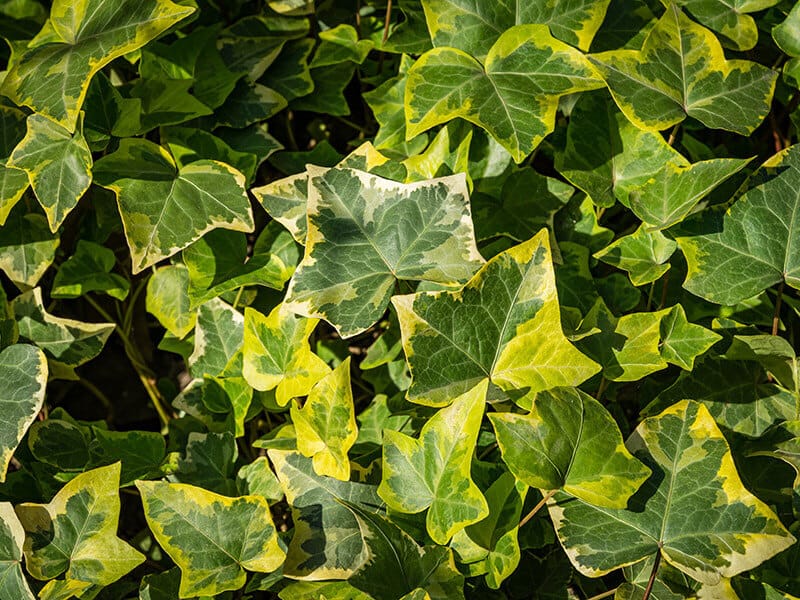
Hedera helix Goldchild is another stunning cultivar of English ivy. The leaves are speckled with cream-yellow at the borders. It is one of the best varieties to grow in the shade. Goldchild ivy can grow up to three feet in height.
You can search for it in nurseries under the name Gold Baby as well.
#29 Buttercup Ivy
Unlike most other ivy varieties, Hedera helix Buttercup is a slow grower. The plant also remains compact, so it can be a perfect choice for small gardens and small trellises.
You can plant it in sun or shade locations. Any fertile soil will work and the plant will only grow up to 1/2 feet as a ground cover. As a trailer, it can grow taller.
#30 Ivalace Ivy
Hedera helix Ivalace features five-lobed leaves. This evergreen climber thrives in chalk soil but will adapt to most other soil types.
It is a low-maintenance plant, which grows best when left alone! Ivalace ivy remains compact, so it is a good houseplant, ground cover, or common part of small topiaries.
When you water the plant regularly, it develops stunning fall color!
Ivy – A Great Way To Improve Every Landscape Even If You Don’t Have Garden
Ivy grows on walls, fences, and can be a much-needed touch of green on a northern wall. Most ivy varieties are easy to grow and spread fast.
But, if ivy grows around the tree, it adds unnecessary weight and can weaken the plant. You can control your ivy by regular pruning and training it to grow on the structure you provide!
Which ivy type looks the most appealing to you? I hope the article was useful to you!
